Strategic Human Resource Management: Practices, Ethics, and Future
VerifiedAdded on 2023/06/03
|9
|2136
|225
Report
AI Summary
This report provides an overview of strategic human resource management (SHRM), evaluating its practices, limitations, and future impact. It begins by defining HRM and SHRM, then delves into the limitations of traditional HRM practices, using examples like Enron and Toyota to illustrate issues in performance management, corporate culture, and risk assessment. The report further explores how SHRM can transform the future by focusing on internal consulting, talent management, skill-based performance management, and proactive risk assessment. It emphasizes the importance of ethics and social sustainability in HRM practices for ensuring organizational growth and profitability. The conclusion highlights the significance of SHRM in addressing both internal and external challenges, advocating for the integration of ethical and sustainable practices.
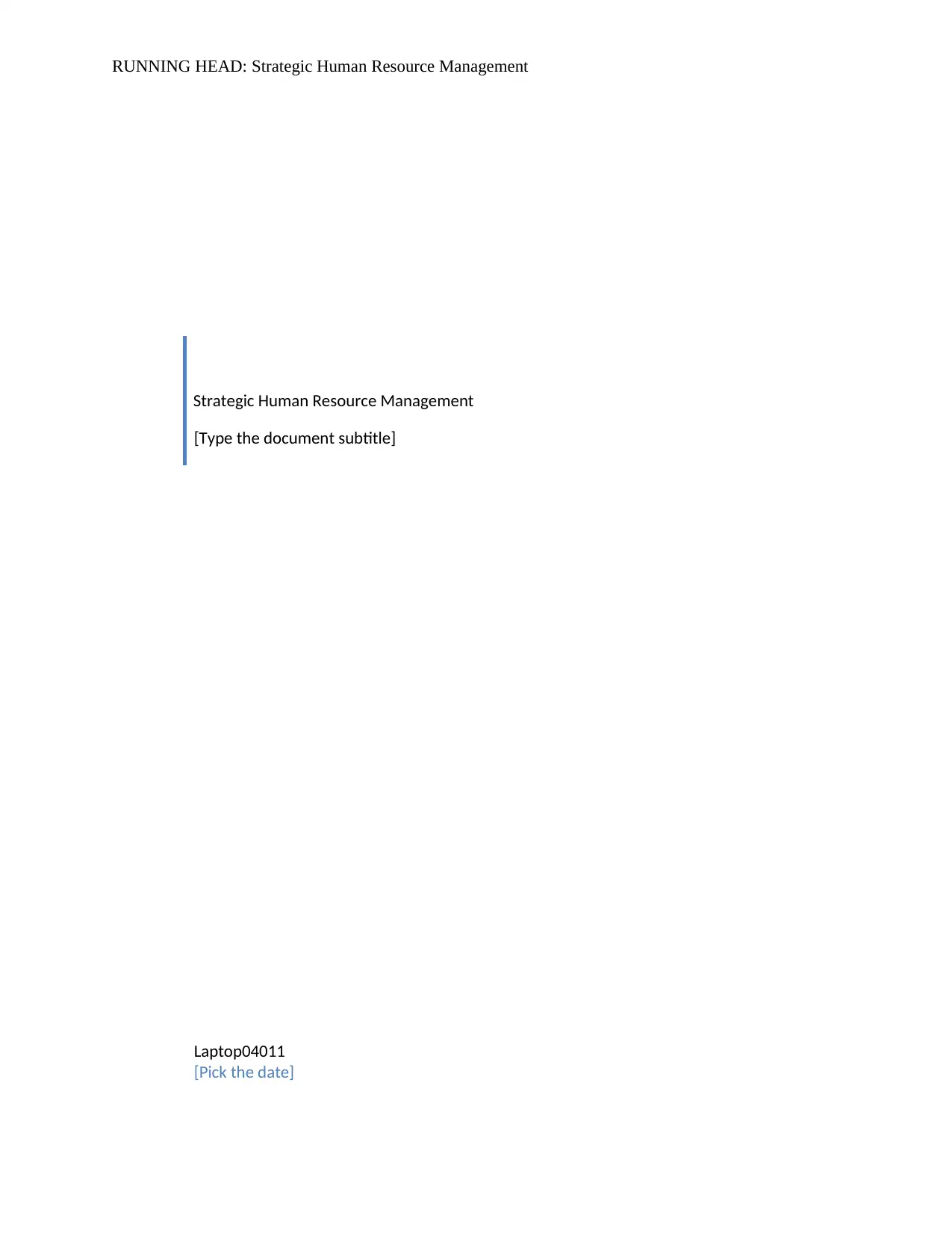
RUNNING HEAD: Strategic Human Resource Management
Strategic Human Resource Management
[Type the document subtitle]
Laptop04011
[Pick the date]
Strategic Human Resource Management
[Type the document subtitle]
Laptop04011
[Pick the date]
Paraphrase This Document
Need a fresh take? Get an instant paraphrase of this document with our AI Paraphraser
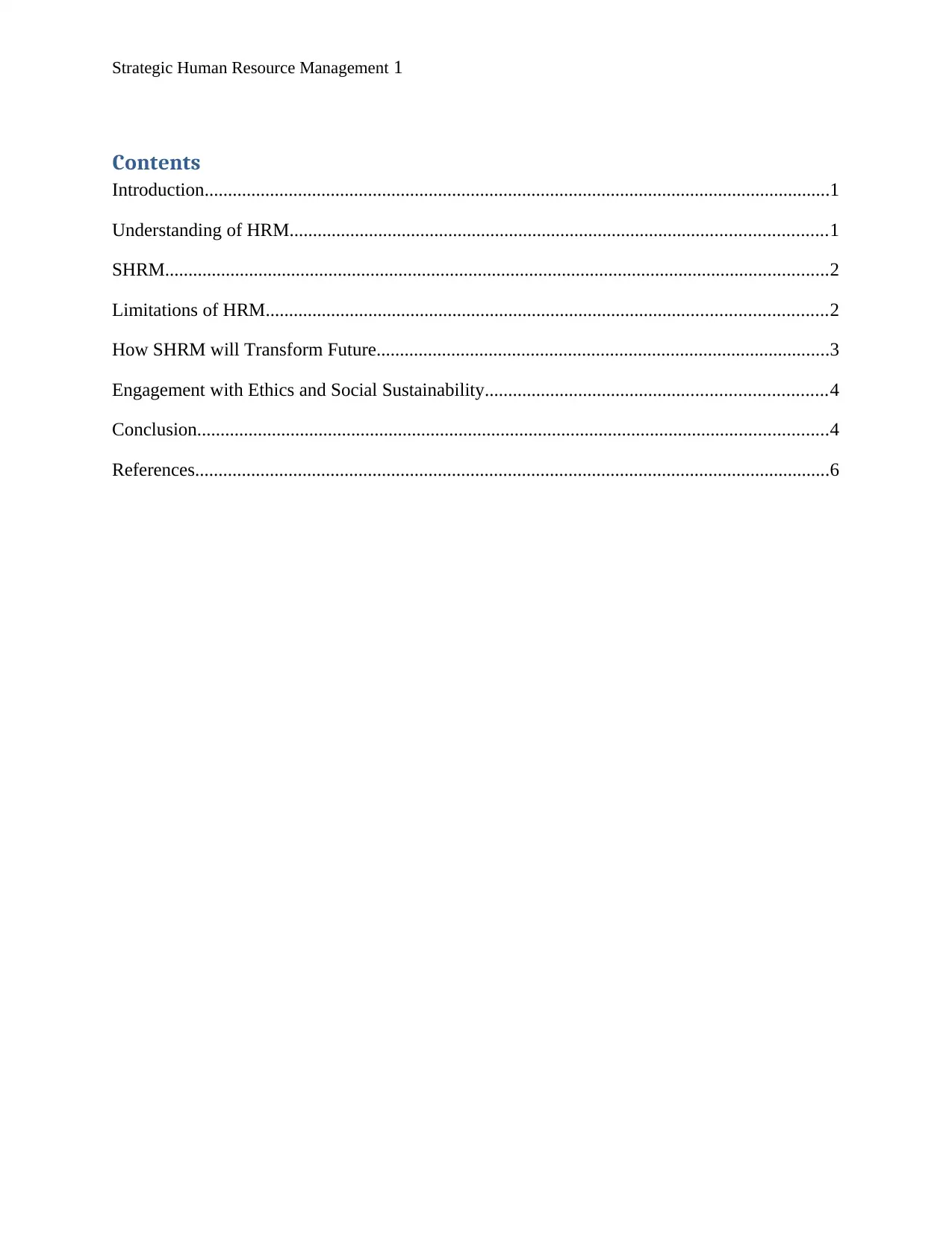
Strategic Human Resource Management 1
Contents
Introduction......................................................................................................................................1
Understanding of HRM...................................................................................................................1
SHRM..............................................................................................................................................2
Limitations of HRM........................................................................................................................2
How SHRM will Transform Future.................................................................................................3
Engagement with Ethics and Social Sustainability.........................................................................4
Conclusion.......................................................................................................................................4
References........................................................................................................................................6
Contents
Introduction......................................................................................................................................1
Understanding of HRM...................................................................................................................1
SHRM..............................................................................................................................................2
Limitations of HRM........................................................................................................................2
How SHRM will Transform Future.................................................................................................3
Engagement with Ethics and Social Sustainability.........................................................................4
Conclusion.......................................................................................................................................4
References........................................................................................................................................6
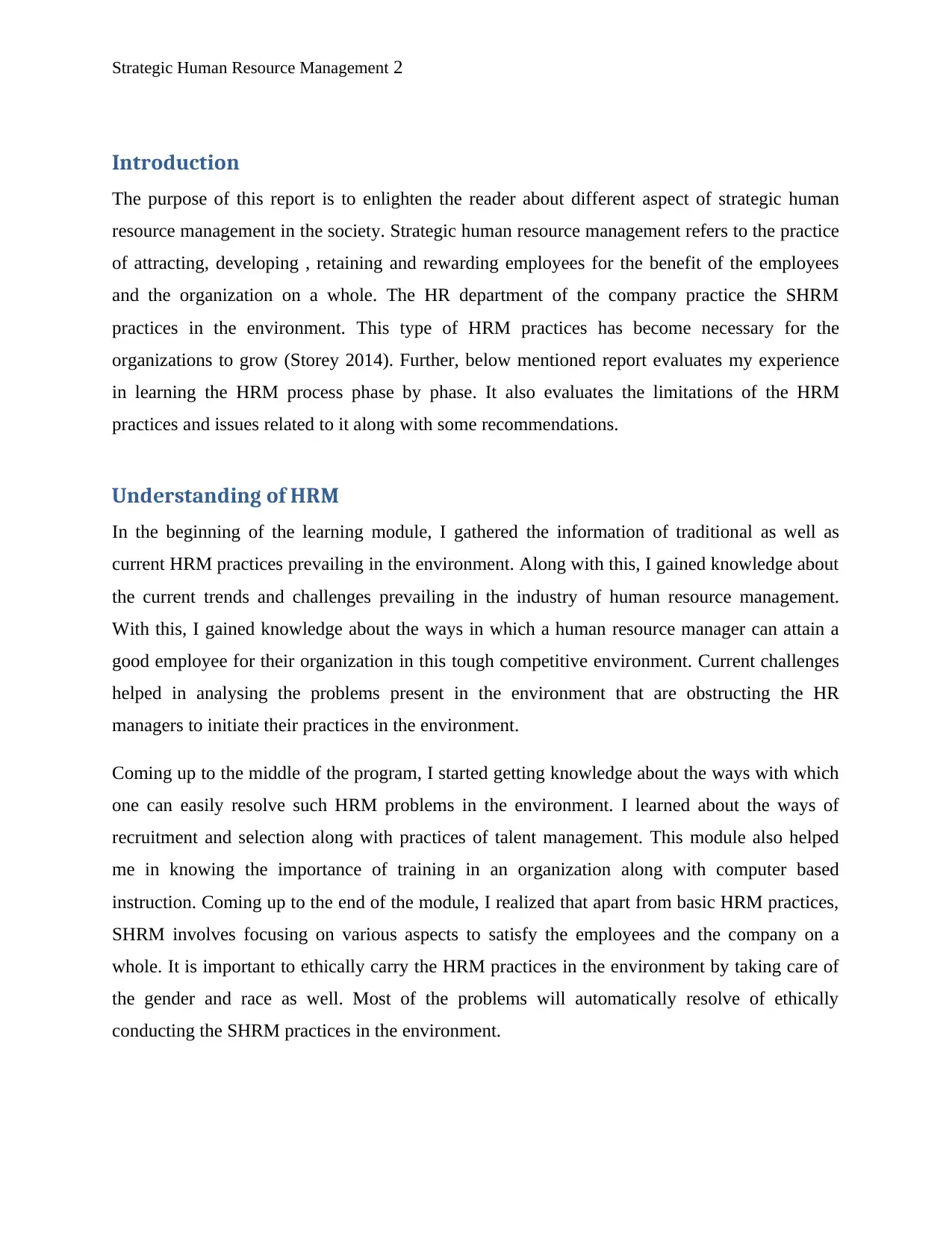
Strategic Human Resource Management 2
Introduction
The purpose of this report is to enlighten the reader about different aspect of strategic human
resource management in the society. Strategic human resource management refers to the practice
of attracting, developing , retaining and rewarding employees for the benefit of the employees
and the organization on a whole. The HR department of the company practice the SHRM
practices in the environment. This type of HRM practices has become necessary for the
organizations to grow (Storey 2014). Further, below mentioned report evaluates my experience
in learning the HRM process phase by phase. It also evaluates the limitations of the HRM
practices and issues related to it along with some recommendations.
Understanding of HRM
In the beginning of the learning module, I gathered the information of traditional as well as
current HRM practices prevailing in the environment. Along with this, I gained knowledge about
the current trends and challenges prevailing in the industry of human resource management.
With this, I gained knowledge about the ways in which a human resource manager can attain a
good employee for their organization in this tough competitive environment. Current challenges
helped in analysing the problems present in the environment that are obstructing the HR
managers to initiate their practices in the environment.
Coming up to the middle of the program, I started getting knowledge about the ways with which
one can easily resolve such HRM problems in the environment. I learned about the ways of
recruitment and selection along with practices of talent management. This module also helped
me in knowing the importance of training in an organization along with computer based
instruction. Coming up to the end of the module, I realized that apart from basic HRM practices,
SHRM involves focusing on various aspects to satisfy the employees and the company on a
whole. It is important to ethically carry the HRM practices in the environment by taking care of
the gender and race as well. Most of the problems will automatically resolve of ethically
conducting the SHRM practices in the environment.
Introduction
The purpose of this report is to enlighten the reader about different aspect of strategic human
resource management in the society. Strategic human resource management refers to the practice
of attracting, developing , retaining and rewarding employees for the benefit of the employees
and the organization on a whole. The HR department of the company practice the SHRM
practices in the environment. This type of HRM practices has become necessary for the
organizations to grow (Storey 2014). Further, below mentioned report evaluates my experience
in learning the HRM process phase by phase. It also evaluates the limitations of the HRM
practices and issues related to it along with some recommendations.
Understanding of HRM
In the beginning of the learning module, I gathered the information of traditional as well as
current HRM practices prevailing in the environment. Along with this, I gained knowledge about
the current trends and challenges prevailing in the industry of human resource management.
With this, I gained knowledge about the ways in which a human resource manager can attain a
good employee for their organization in this tough competitive environment. Current challenges
helped in analysing the problems present in the environment that are obstructing the HR
managers to initiate their practices in the environment.
Coming up to the middle of the program, I started getting knowledge about the ways with which
one can easily resolve such HRM problems in the environment. I learned about the ways of
recruitment and selection along with practices of talent management. This module also helped
me in knowing the importance of training in an organization along with computer based
instruction. Coming up to the end of the module, I realized that apart from basic HRM practices,
SHRM involves focusing on various aspects to satisfy the employees and the company on a
whole. It is important to ethically carry the HRM practices in the environment by taking care of
the gender and race as well. Most of the problems will automatically resolve of ethically
conducting the SHRM practices in the environment.
⊘ This is a preview!⊘
Do you want full access?
Subscribe today to unlock all pages.

Trusted by 1+ million students worldwide
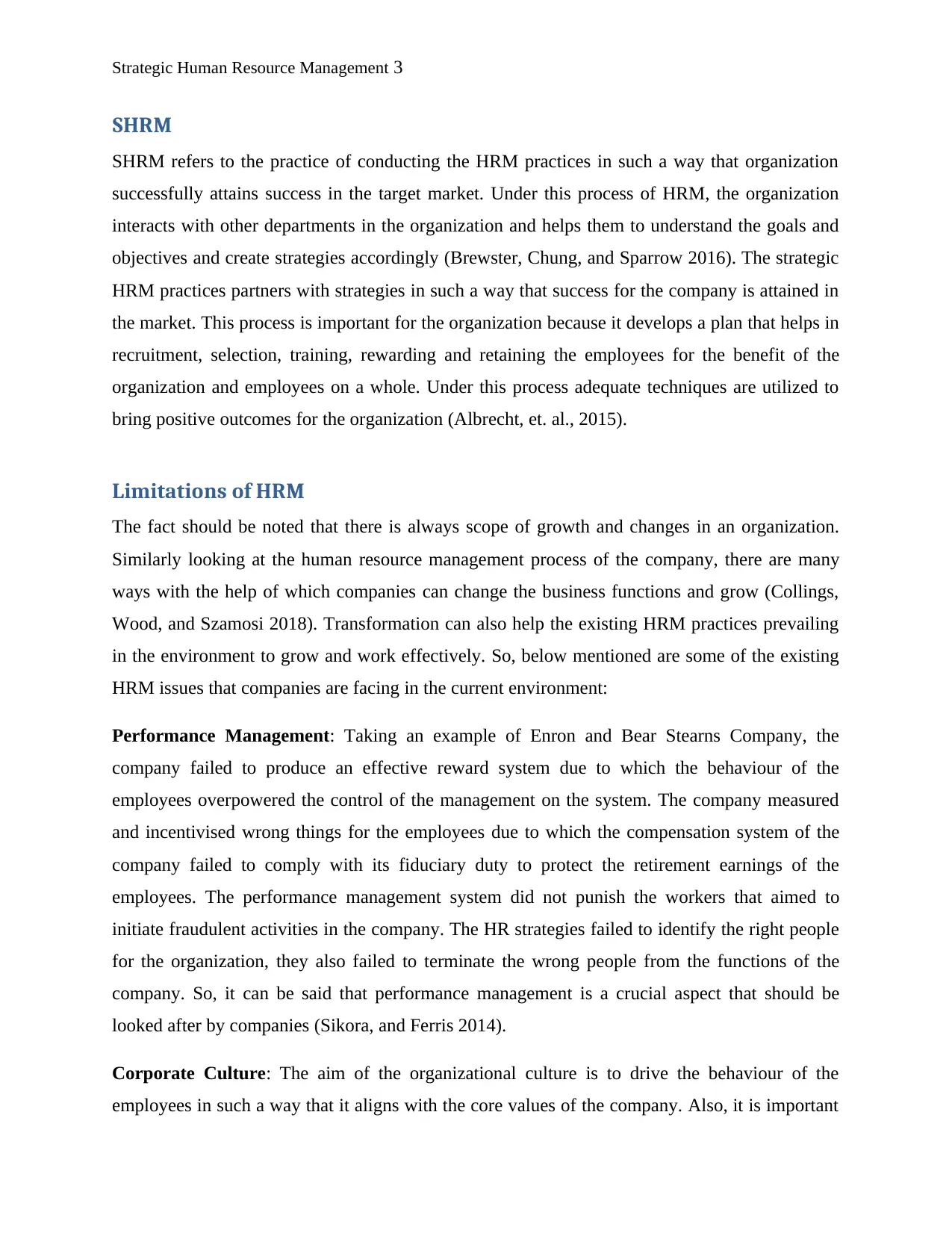
Strategic Human Resource Management 3
SHRM
SHRM refers to the practice of conducting the HRM practices in such a way that organization
successfully attains success in the target market. Under this process of HRM, the organization
interacts with other departments in the organization and helps them to understand the goals and
objectives and create strategies accordingly (Brewster, Chung, and Sparrow 2016). The strategic
HRM practices partners with strategies in such a way that success for the company is attained in
the market. This process is important for the organization because it develops a plan that helps in
recruitment, selection, training, rewarding and retaining the employees for the benefit of the
organization and employees on a whole. Under this process adequate techniques are utilized to
bring positive outcomes for the organization (Albrecht, et. al., 2015).
Limitations of HRM
The fact should be noted that there is always scope of growth and changes in an organization.
Similarly looking at the human resource management process of the company, there are many
ways with the help of which companies can change the business functions and grow (Collings,
Wood, and Szamosi 2018). Transformation can also help the existing HRM practices prevailing
in the environment to grow and work effectively. So, below mentioned are some of the existing
HRM issues that companies are facing in the current environment:
Performance Management: Taking an example of Enron and Bear Stearns Company, the
company failed to produce an effective reward system due to which the behaviour of the
employees overpowered the control of the management on the system. The company measured
and incentivised wrong things for the employees due to which the compensation system of the
company failed to comply with its fiduciary duty to protect the retirement earnings of the
employees. The performance management system did not punish the workers that aimed to
initiate fraudulent activities in the company. The HR strategies failed to identify the right people
for the organization, they also failed to terminate the wrong people from the functions of the
company. So, it can be said that performance management is a crucial aspect that should be
looked after by companies (Sikora, and Ferris 2014).
Corporate Culture: The aim of the organizational culture is to drive the behaviour of the
employees in such a way that it aligns with the core values of the company. Also, it is important
SHRM
SHRM refers to the practice of conducting the HRM practices in such a way that organization
successfully attains success in the target market. Under this process of HRM, the organization
interacts with other departments in the organization and helps them to understand the goals and
objectives and create strategies accordingly (Brewster, Chung, and Sparrow 2016). The strategic
HRM practices partners with strategies in such a way that success for the company is attained in
the market. This process is important for the organization because it develops a plan that helps in
recruitment, selection, training, rewarding and retaining the employees for the benefit of the
organization and employees on a whole. Under this process adequate techniques are utilized to
bring positive outcomes for the organization (Albrecht, et. al., 2015).
Limitations of HRM
The fact should be noted that there is always scope of growth and changes in an organization.
Similarly looking at the human resource management process of the company, there are many
ways with the help of which companies can change the business functions and grow (Collings,
Wood, and Szamosi 2018). Transformation can also help the existing HRM practices prevailing
in the environment to grow and work effectively. So, below mentioned are some of the existing
HRM issues that companies are facing in the current environment:
Performance Management: Taking an example of Enron and Bear Stearns Company, the
company failed to produce an effective reward system due to which the behaviour of the
employees overpowered the control of the management on the system. The company measured
and incentivised wrong things for the employees due to which the compensation system of the
company failed to comply with its fiduciary duty to protect the retirement earnings of the
employees. The performance management system did not punish the workers that aimed to
initiate fraudulent activities in the company. The HR strategies failed to identify the right people
for the organization, they also failed to terminate the wrong people from the functions of the
company. So, it can be said that performance management is a crucial aspect that should be
looked after by companies (Sikora, and Ferris 2014).
Corporate Culture: The aim of the organizational culture is to drive the behaviour of the
employees in such a way that it aligns with the core values of the company. Also, it is important
Paraphrase This Document
Need a fresh take? Get an instant paraphrase of this document with our AI Paraphraser
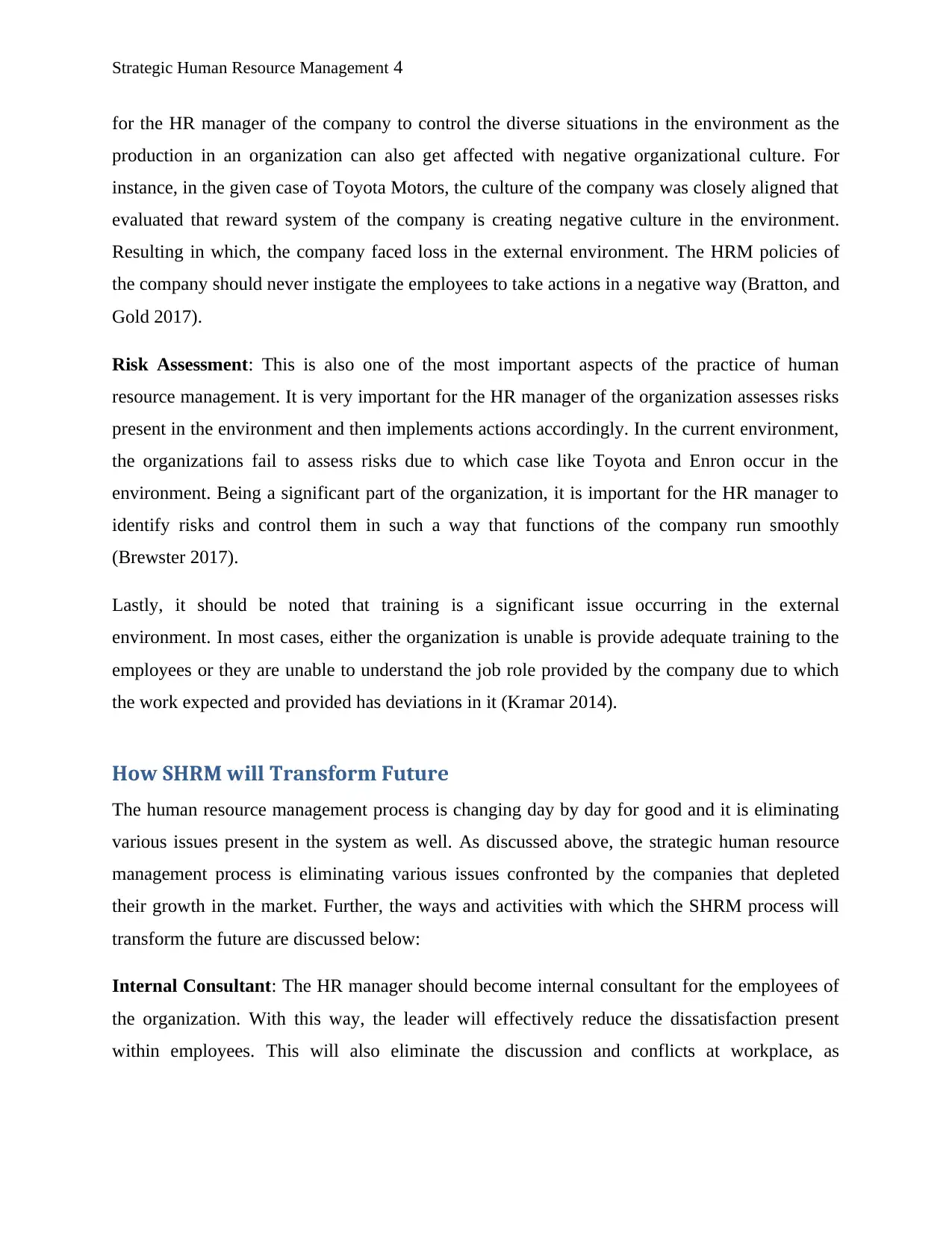
Strategic Human Resource Management 4
for the HR manager of the company to control the diverse situations in the environment as the
production in an organization can also get affected with negative organizational culture. For
instance, in the given case of Toyota Motors, the culture of the company was closely aligned that
evaluated that reward system of the company is creating negative culture in the environment.
Resulting in which, the company faced loss in the external environment. The HRM policies of
the company should never instigate the employees to take actions in a negative way (Bratton, and
Gold 2017).
Risk Assessment: This is also one of the most important aspects of the practice of human
resource management. It is very important for the HR manager of the organization assesses risks
present in the environment and then implements actions accordingly. In the current environment,
the organizations fail to assess risks due to which case like Toyota and Enron occur in the
environment. Being a significant part of the organization, it is important for the HR manager to
identify risks and control them in such a way that functions of the company run smoothly
(Brewster 2017).
Lastly, it should be noted that training is a significant issue occurring in the external
environment. In most cases, either the organization is unable is provide adequate training to the
employees or they are unable to understand the job role provided by the company due to which
the work expected and provided has deviations in it (Kramar 2014).
How SHRM will Transform Future
The human resource management process is changing day by day for good and it is eliminating
various issues present in the system as well. As discussed above, the strategic human resource
management process is eliminating various issues confronted by the companies that depleted
their growth in the market. Further, the ways and activities with which the SHRM process will
transform the future are discussed below:
Internal Consultant: The HR manager should become internal consultant for the employees of
the organization. With this way, the leader will effectively reduce the dissatisfaction present
within employees. This will also eliminate the discussion and conflicts at workplace, as
for the HR manager of the company to control the diverse situations in the environment as the
production in an organization can also get affected with negative organizational culture. For
instance, in the given case of Toyota Motors, the culture of the company was closely aligned that
evaluated that reward system of the company is creating negative culture in the environment.
Resulting in which, the company faced loss in the external environment. The HRM policies of
the company should never instigate the employees to take actions in a negative way (Bratton, and
Gold 2017).
Risk Assessment: This is also one of the most important aspects of the practice of human
resource management. It is very important for the HR manager of the organization assesses risks
present in the environment and then implements actions accordingly. In the current environment,
the organizations fail to assess risks due to which case like Toyota and Enron occur in the
environment. Being a significant part of the organization, it is important for the HR manager to
identify risks and control them in such a way that functions of the company run smoothly
(Brewster 2017).
Lastly, it should be noted that training is a significant issue occurring in the external
environment. In most cases, either the organization is unable is provide adequate training to the
employees or they are unable to understand the job role provided by the company due to which
the work expected and provided has deviations in it (Kramar 2014).
How SHRM will Transform Future
The human resource management process is changing day by day for good and it is eliminating
various issues present in the system as well. As discussed above, the strategic human resource
management process is eliminating various issues confronted by the companies that depleted
their growth in the market. Further, the ways and activities with which the SHRM process will
transform the future are discussed below:
Internal Consultant: The HR manager should become internal consultant for the employees of
the organization. With this way, the leader will effectively reduce the dissatisfaction present
within employees. This will also eliminate the discussion and conflicts at workplace, as
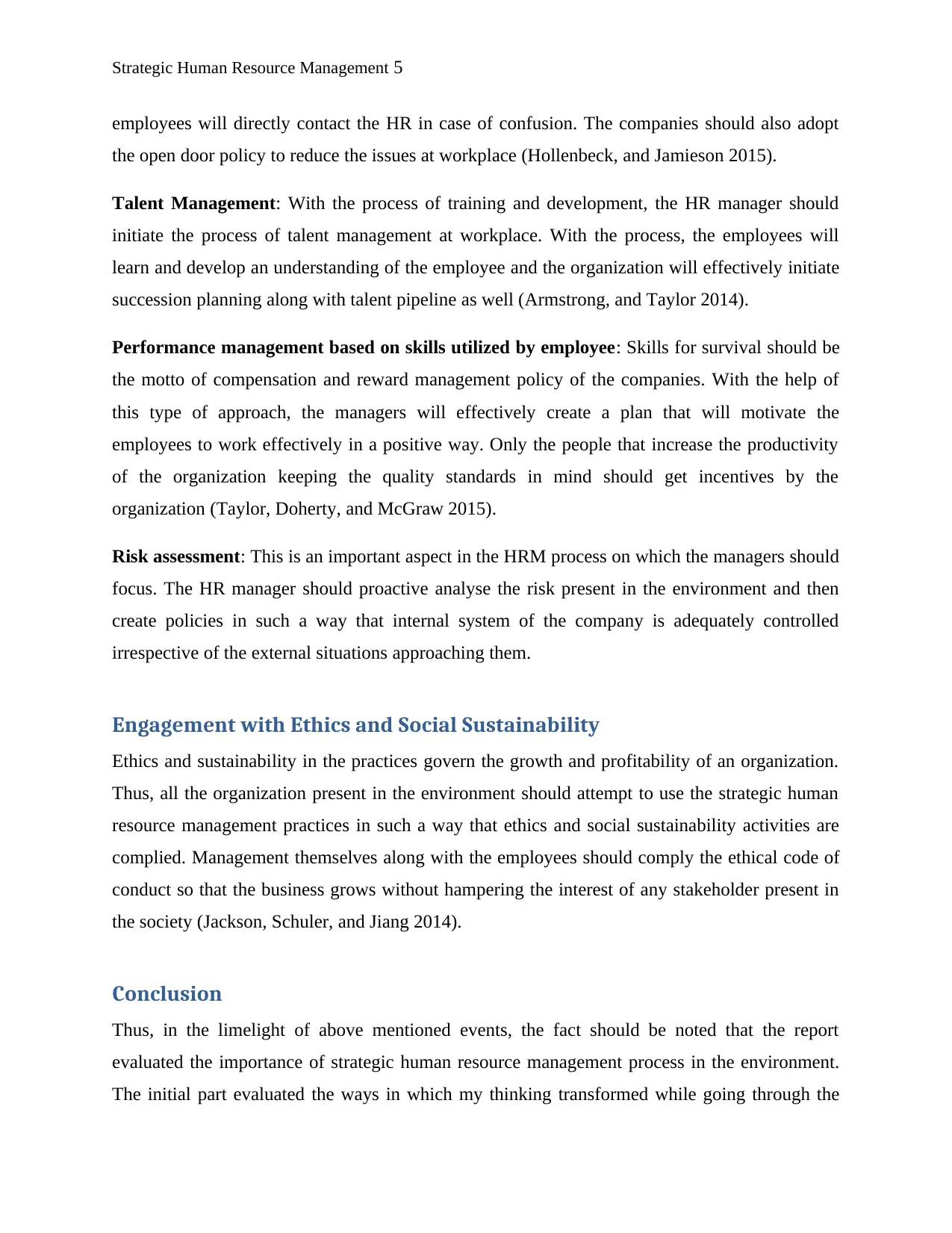
Strategic Human Resource Management 5
employees will directly contact the HR in case of confusion. The companies should also adopt
the open door policy to reduce the issues at workplace (Hollenbeck, and Jamieson 2015).
Talent Management: With the process of training and development, the HR manager should
initiate the process of talent management at workplace. With the process, the employees will
learn and develop an understanding of the employee and the organization will effectively initiate
succession planning along with talent pipeline as well (Armstrong, and Taylor 2014).
Performance management based on skills utilized by employee: Skills for survival should be
the motto of compensation and reward management policy of the companies. With the help of
this type of approach, the managers will effectively create a plan that will motivate the
employees to work effectively in a positive way. Only the people that increase the productivity
of the organization keeping the quality standards in mind should get incentives by the
organization (Taylor, Doherty, and McGraw 2015).
Risk assessment: This is an important aspect in the HRM process on which the managers should
focus. The HR manager should proactive analyse the risk present in the environment and then
create policies in such a way that internal system of the company is adequately controlled
irrespective of the external situations approaching them.
Engagement with Ethics and Social Sustainability
Ethics and sustainability in the practices govern the growth and profitability of an organization.
Thus, all the organization present in the environment should attempt to use the strategic human
resource management practices in such a way that ethics and social sustainability activities are
complied. Management themselves along with the employees should comply the ethical code of
conduct so that the business grows without hampering the interest of any stakeholder present in
the society (Jackson, Schuler, and Jiang 2014).
Conclusion
Thus, in the limelight of above mentioned events, the fact should be noted that the report
evaluated the importance of strategic human resource management process in the environment.
The initial part evaluated the ways in which my thinking transformed while going through the
employees will directly contact the HR in case of confusion. The companies should also adopt
the open door policy to reduce the issues at workplace (Hollenbeck, and Jamieson 2015).
Talent Management: With the process of training and development, the HR manager should
initiate the process of talent management at workplace. With the process, the employees will
learn and develop an understanding of the employee and the organization will effectively initiate
succession planning along with talent pipeline as well (Armstrong, and Taylor 2014).
Performance management based on skills utilized by employee: Skills for survival should be
the motto of compensation and reward management policy of the companies. With the help of
this type of approach, the managers will effectively create a plan that will motivate the
employees to work effectively in a positive way. Only the people that increase the productivity
of the organization keeping the quality standards in mind should get incentives by the
organization (Taylor, Doherty, and McGraw 2015).
Risk assessment: This is an important aspect in the HRM process on which the managers should
focus. The HR manager should proactive analyse the risk present in the environment and then
create policies in such a way that internal system of the company is adequately controlled
irrespective of the external situations approaching them.
Engagement with Ethics and Social Sustainability
Ethics and sustainability in the practices govern the growth and profitability of an organization.
Thus, all the organization present in the environment should attempt to use the strategic human
resource management practices in such a way that ethics and social sustainability activities are
complied. Management themselves along with the employees should comply the ethical code of
conduct so that the business grows without hampering the interest of any stakeholder present in
the society (Jackson, Schuler, and Jiang 2014).
Conclusion
Thus, in the limelight of above mentioned events, the fact should be noted that the report
evaluated the importance of strategic human resource management process in the environment.
The initial part evaluated the ways in which my thinking transformed while going through the
⊘ This is a preview!⊘
Do you want full access?
Subscribe today to unlock all pages.

Trusted by 1+ million students worldwide
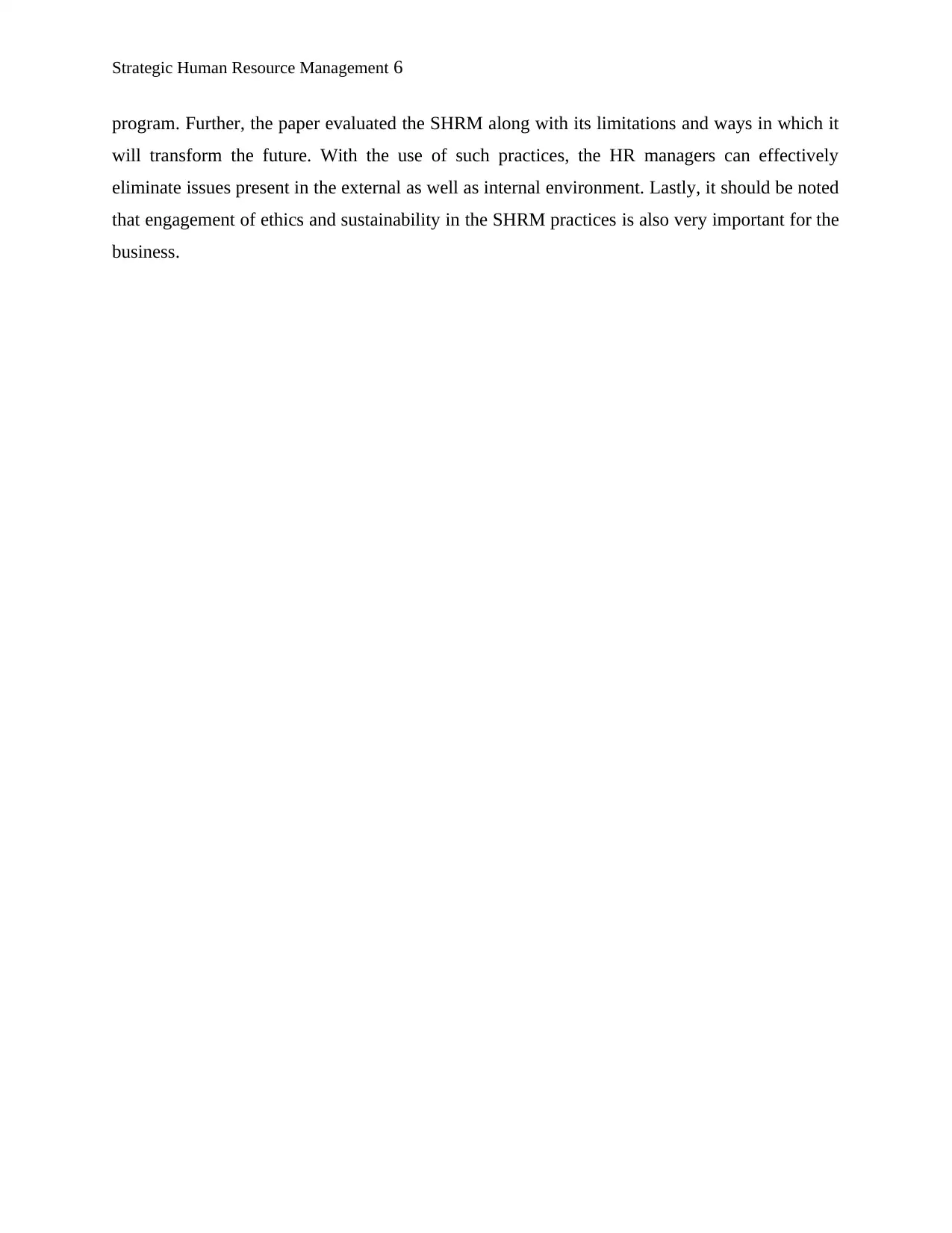
Strategic Human Resource Management 6
program. Further, the paper evaluated the SHRM along with its limitations and ways in which it
will transform the future. With the use of such practices, the HR managers can effectively
eliminate issues present in the external as well as internal environment. Lastly, it should be noted
that engagement of ethics and sustainability in the SHRM practices is also very important for the
business.
program. Further, the paper evaluated the SHRM along with its limitations and ways in which it
will transform the future. With the use of such practices, the HR managers can effectively
eliminate issues present in the external as well as internal environment. Lastly, it should be noted
that engagement of ethics and sustainability in the SHRM practices is also very important for the
business.
Paraphrase This Document
Need a fresh take? Get an instant paraphrase of this document with our AI Paraphraser
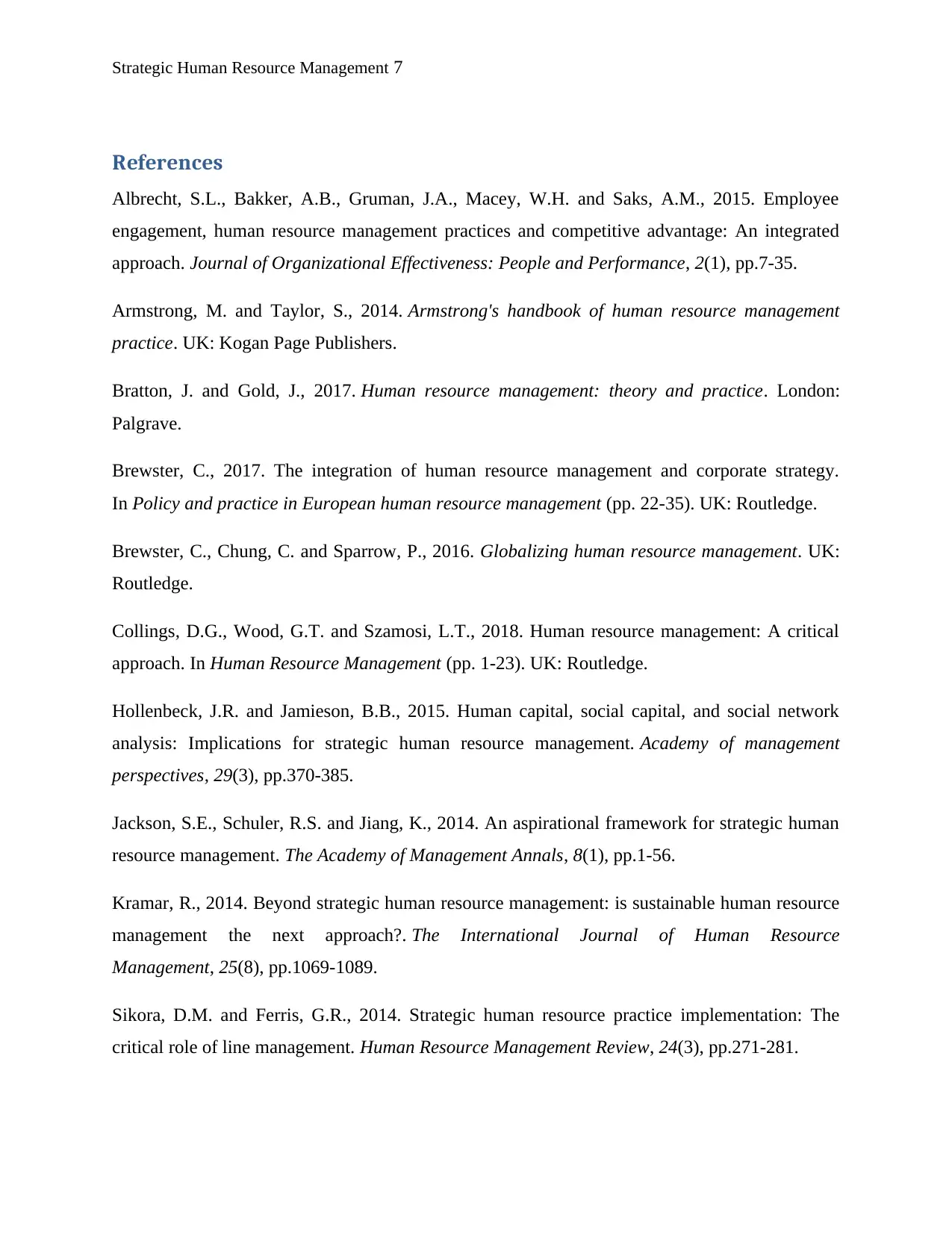
Strategic Human Resource Management 7
References
Albrecht, S.L., Bakker, A.B., Gruman, J.A., Macey, W.H. and Saks, A.M., 2015. Employee
engagement, human resource management practices and competitive advantage: An integrated
approach. Journal of Organizational Effectiveness: People and Performance, 2(1), pp.7-35.
Armstrong, M. and Taylor, S., 2014. Armstrong's handbook of human resource management
practice. UK: Kogan Page Publishers.
Bratton, J. and Gold, J., 2017. Human resource management: theory and practice. London:
Palgrave.
Brewster, C., 2017. The integration of human resource management and corporate strategy.
In Policy and practice in European human resource management (pp. 22-35). UK: Routledge.
Brewster, C., Chung, C. and Sparrow, P., 2016. Globalizing human resource management. UK:
Routledge.
Collings, D.G., Wood, G.T. and Szamosi, L.T., 2018. Human resource management: A critical
approach. In Human Resource Management (pp. 1-23). UK: Routledge.
Hollenbeck, J.R. and Jamieson, B.B., 2015. Human capital, social capital, and social network
analysis: Implications for strategic human resource management. Academy of management
perspectives, 29(3), pp.370-385.
Jackson, S.E., Schuler, R.S. and Jiang, K., 2014. An aspirational framework for strategic human
resource management. The Academy of Management Annals, 8(1), pp.1-56.
Kramar, R., 2014. Beyond strategic human resource management: is sustainable human resource
management the next approach?. The International Journal of Human Resource
Management, 25(8), pp.1069-1089.
Sikora, D.M. and Ferris, G.R., 2014. Strategic human resource practice implementation: The
critical role of line management. Human Resource Management Review, 24(3), pp.271-281.
References
Albrecht, S.L., Bakker, A.B., Gruman, J.A., Macey, W.H. and Saks, A.M., 2015. Employee
engagement, human resource management practices and competitive advantage: An integrated
approach. Journal of Organizational Effectiveness: People and Performance, 2(1), pp.7-35.
Armstrong, M. and Taylor, S., 2014. Armstrong's handbook of human resource management
practice. UK: Kogan Page Publishers.
Bratton, J. and Gold, J., 2017. Human resource management: theory and practice. London:
Palgrave.
Brewster, C., 2017. The integration of human resource management and corporate strategy.
In Policy and practice in European human resource management (pp. 22-35). UK: Routledge.
Brewster, C., Chung, C. and Sparrow, P., 2016. Globalizing human resource management. UK:
Routledge.
Collings, D.G., Wood, G.T. and Szamosi, L.T., 2018. Human resource management: A critical
approach. In Human Resource Management (pp. 1-23). UK: Routledge.
Hollenbeck, J.R. and Jamieson, B.B., 2015. Human capital, social capital, and social network
analysis: Implications for strategic human resource management. Academy of management
perspectives, 29(3), pp.370-385.
Jackson, S.E., Schuler, R.S. and Jiang, K., 2014. An aspirational framework for strategic human
resource management. The Academy of Management Annals, 8(1), pp.1-56.
Kramar, R., 2014. Beyond strategic human resource management: is sustainable human resource
management the next approach?. The International Journal of Human Resource
Management, 25(8), pp.1069-1089.
Sikora, D.M. and Ferris, G.R., 2014. Strategic human resource practice implementation: The
critical role of line management. Human Resource Management Review, 24(3), pp.271-281.
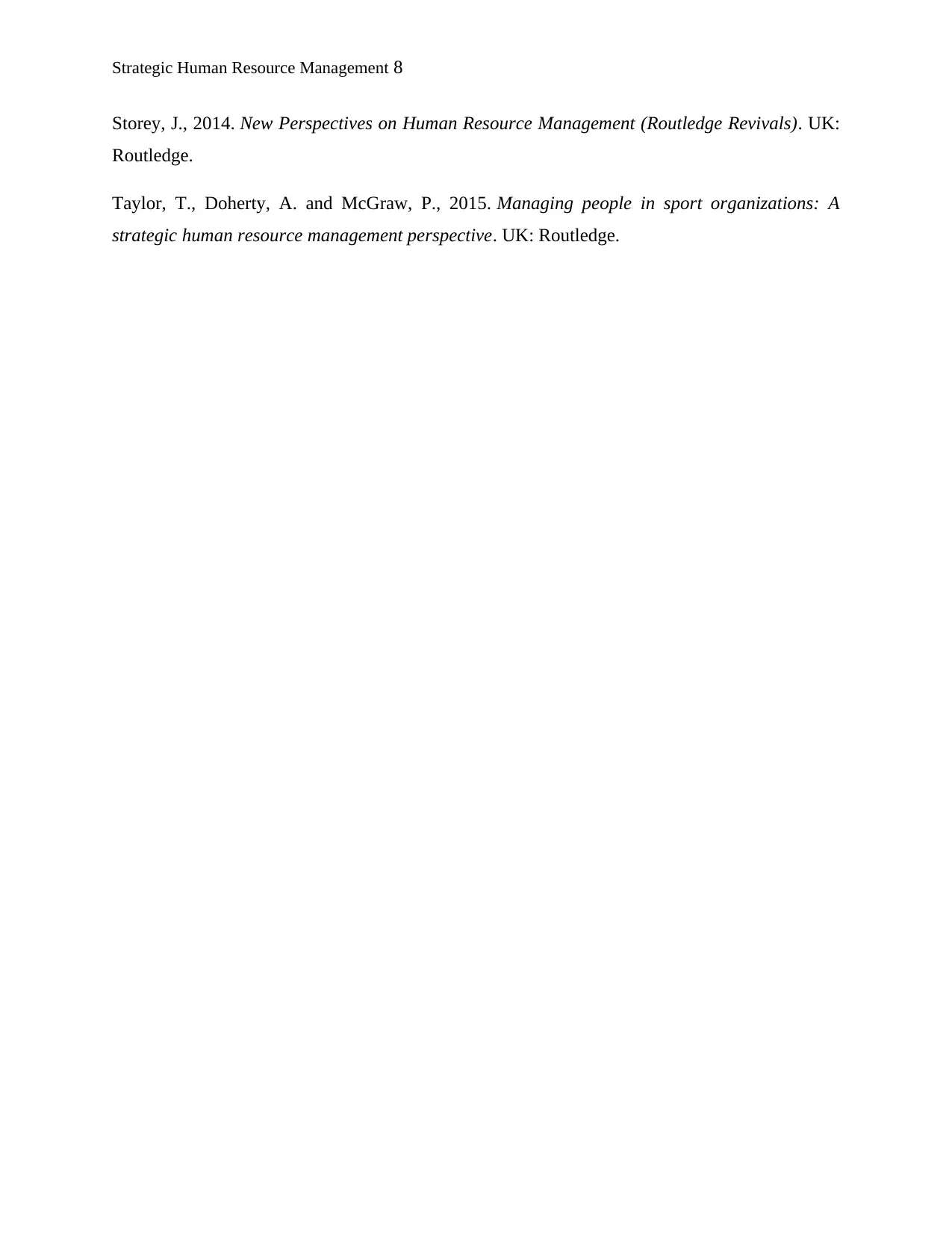
Strategic Human Resource Management 8
Storey, J., 2014. New Perspectives on Human Resource Management (Routledge Revivals). UK:
Routledge.
Taylor, T., Doherty, A. and McGraw, P., 2015. Managing people in sport organizations: A
strategic human resource management perspective. UK: Routledge.
Storey, J., 2014. New Perspectives on Human Resource Management (Routledge Revivals). UK:
Routledge.
Taylor, T., Doherty, A. and McGraw, P., 2015. Managing people in sport organizations: A
strategic human resource management perspective. UK: Routledge.
⊘ This is a preview!⊘
Do you want full access?
Subscribe today to unlock all pages.

Trusted by 1+ million students worldwide
1 out of 9
Related Documents
Your All-in-One AI-Powered Toolkit for Academic Success.
+13062052269
info@desklib.com
Available 24*7 on WhatsApp / Email
![[object Object]](/_next/static/media/star-bottom.7253800d.svg)
Unlock your academic potential
Copyright © 2020–2025 A2Z Services. All Rights Reserved. Developed and managed by ZUCOL.





